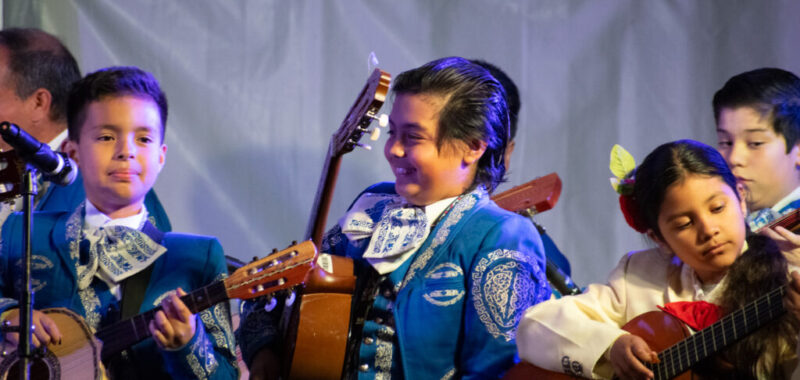
credit: Allie Palomera from SCCOE
Zaida Ramos first learned the magic of mariachi from her father when she was a little girl. Now they make music together, running the bilingual music program for San Jose’s Alum Rock Union School District.
Her father, Juan, is the maestro, the music director. She’s the program director. The father and daughter duo collaborate to share the culture and heritage of mariachi music with their students. The Ramos clan has been teaching children music for more than two decades. It’s a veritable family business.
“Mariachi is how I grew up. In my family, we were always singing,” said Ramos, a vocalist who also plays the violin. “It’s so fulfilling for us, so rewarding, to share mariachi with the families and with the whole community. Everybody is part of the performance because everybody’s connected to these songs, you know? Many times you’ll hear the audience sing along, they laugh, they cry. It resonates with everybody in some way, it’s their story.”
Students from third to eighth grade gather after school and during the summer to steep in the folkloric music of the southwest region of Mexico, a musical tradition marked by stringed instruments, strolling musicians clad in intricately embroidered costumes and a distinctive yell known as a “grito.” The youngsters in this program learn how to play instruments, including the guitarron, guitar, vihuela, violin, and the trumpet and to sing, art forms that require equal parts creativity and discipline. They also learn the beauty and fluidity of ballet folklorico.
“I am really driven by the ideal of a free and public education, and the arts need to be part of that,” said Sofia Fojas, arts coordinator for the Santa Clara County Office of Education. “Music and the arts are part of being human. It’s a universal language, a way to bridge the different cultures we see in the classroom in California. It’s really about the importance of arts and culture and engaging youth who traditionally have not had access.”
 credit: Allie Palomera from SCCOE
credit: Allie Palomera from SCCOEThrough the study of mariachi, children from this predominantly Latino district learn that music is more than sound. It’s also about identity, history and culture. Mariachi contains myriad meanings because there is great nuance and complexity embedded in its notes. While the melodies evoke Mexican heritage, with roots deep in the country’s colonial period, many of the themes are also universal.
“I believe that by embracing our cultural heritage and sharing our stories through music, we can inspire positive change and create a more harmonious society,” said Guillermo Tejeda, a musician who specializes in teaching history, jazz and mariachi to youth. “It’s incredibly rewarding to see how music can empower and inspire young people in our community.”
Carrying this rich artistic tradition into a new generation is part of what drives Ramos. She sees mariachi as a way to connect students to their own unique voice as well as the collective spirit of their community.
“I always tell them, you are ambassadors of your whole community,” said Ramos, who also works in real estate. “Wherever you go, you are not only representing East San Jose, you’re representing a whole culture. You’re representing Mexican culture and you’re representing mariachi. There’s a sense of pride in who you are.”
Struggle is often a part of the stories told in mariachi music. It’s also part of the reality of teaching music in a time of tight budgets and declining enrollment. While Ramos is cheered by how many of her students acquire a lifelong love of music, she wishes she didn’t always have to fight for more funding.
“We need more teachers, we need more instruments, we need more support, we need more time, we need more classes,” said Ramos, “and that all comes down to budgeting. We have lots of requests for the kids to perform and to represent Alum Rock, but if we don’t have the budget to support it, we can’t do it.”
Many arts advocates are hopeful that an infusion of Proposition 28 funding may help bolster projects like the mariachi program, an arts ed program that represents the cultural heritage of the community.
“Culturally relevant curriculum and instruction helps educators build relationships with students by leveraging what they bring to the classroom,” said Letty Kraus, director of the California County Superintendents Statewide Arts Initiative. “It helps ensure relevance and engagement and maximizes inclusivity.”
The braided nature of art, the way it’s tightly interwoven with history and culture over time, gives mariachi its power. Arts education also opens up avenues of opportunity and possibility for students as well as nurturing a sense of belonging, experts say.
“You’re teaching them about their own past,” said Fojas, who taught orchestra, band and mariachi for 20 years. “The majority of students that I taught were of Mexican descent, so when you’re teaching mariachi, you’re actually teaching them about the history of Mexico.”
In a post-pandemic world, when absenteeism and disengagement are running high, the arts can be a path to teach students how to persevere through adversity. Budding musicians must learn how to have the grit to rehearse tirelessly and then perform fearlessly before an audience. Fojas sees arts education as a magnet to draw students back to school.
“Everybody needs to understand the importance of art,” said Fojas. “Arts is culture, and when you deny people arts, you’re denying them culture, and those cultural artifacts are the things we leave behind. So if we deny youth the ability to participate in the arts, we’re denying future generations the ability to see what we’ve left behind.”

